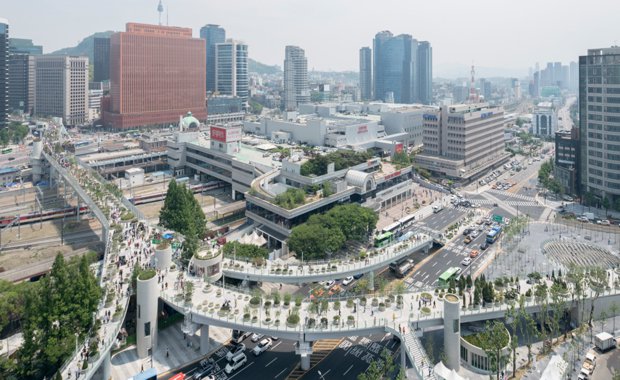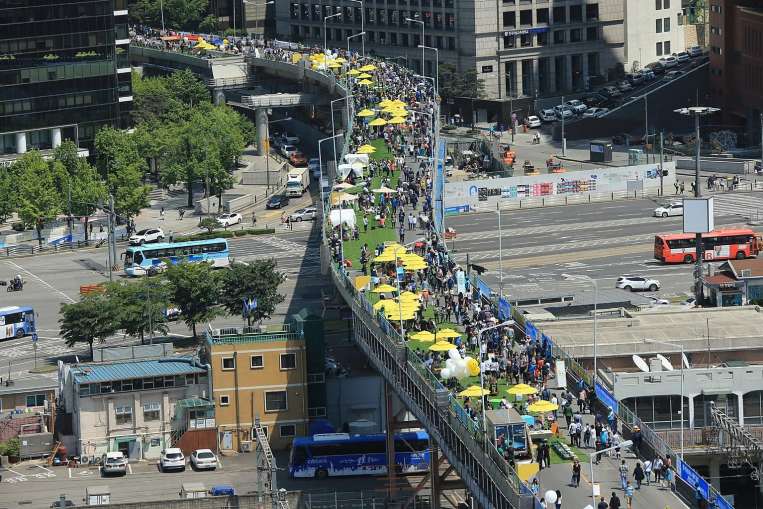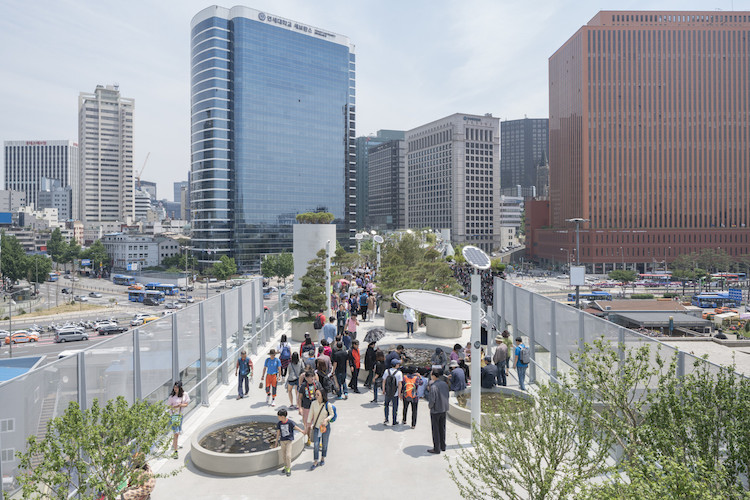
Price Tag readers made some very good comments about how New York City’s High Line is markedly different from Vancouver’s Georgia Viaducts which are scheduled for demolition if the funding can be found. The High Line was an unused railway between a few kilometers of warehouse buildings. But a better parallel is the newly opened Seoul Skygarden which is built on a former motordom “flyover” that connected several locations with the railway station.
Built at a cost of roughly 65 million Canadian dollars, the bridge took two years to be redesigned by the Dutch architects Mts MVRDV. As written by pfsk.com it was designed to give “qualities of walkability, neighbourliness, human scale and shared enjoyment of its places…The Skygarden isn’t the first project designed to revive Seoul; the Cheonggyecheon stream was opened in 2005.”

Called the “Seoul-lo 7017 after the age of the original construction, the Skygarden “ is both a symbol and an instrument of the shift from car to foot. The original concrete structure has been strengthened, and lifts, stairs and escalators have been added where necessary to connect it to the ground. Bridges also connect to adjoining commercial buildings, who have to pay for the uplift in value. Other uses – cafes, performance spaces, a market – are scattered across the site.”
The overpass was planted with a “library of 24,000 plants, all native to Korea and arranged in the order of the Korean alphabet. Once plants mature, they will be sold and replaced, making the library also a nursery according to Winy Maas of the Dutch group MVRDV.
“Young Joon Kim, the current city architect who also worked as the coordinator of the Skygarden project, says that he is “very happy”. He acknowledges that not everyone is pleased about handing over road infrastructure to pedestrians – drivers of cars and commercial vehicles, for example – but says that “when you look at things over a longer period it’s clear that citizens have to have car-free zones. It’s not a kind of taste, it’s the way to go, like many other cities.”














Author
Reblogged this on Sandy James Planner.
The viaducts are not the Highline. Apples and oranges. And I suspect the viaducts have quite a bit more surface area (or shadowed area, depending on your location) than the Skygarden. Further, the Skygarden route appears to cross railyards and a major arterial at a perpendicular angle with no viable alternative, and therefore it is a vital route. The viaducts will have a much better alternate route running parallel to it on the surface that virtually replicates the elevated route that will be eliminated. Note also that a small sliver of one viaduct will be retained as a token nod to the Highline in the NEFC plan.
The Skygarden is a great idea for the right reasons, both practical and aesthetic, as is the Highline. Copying and transporting ideas to other cities without regard to the different site conditions and circumstances is not an adequate way to respect the particular character of cities. The cost of dynamiting the viaducts has become a point of contention by some critics. Well, what about comparing that to the cost of building them to begin with? Vancouver has another solution, and it doesn’t involve maintaining two massive, ugly concrete structures in the sky for little practical purpose. *
There have been several notable road conversion projects around the world recently, but I think the Cheonggyecheon Stream is the most stunningly beautiful urban road transformation of all. Residents of Seoul love and treasure this new park. To gauge the sheer insanity of car addiction (to the point of moral bankruptcy in managing public budgets), try proposing converting the Stream back to a roaring, treacherous freeway. Then watch the citizens explode in anger and grief at the very idea.
* As a tongue-in-cheek gesture, I would consider the retention of one segment of one viaduct and leave it elevated in the centre of the NEFC park after blowing up the rest. Plant vines at the bases of the columns and add a 1.5 m perimeter retaining wall and fresh soil on the elevated former road surface, then document the slow erosion and takeover of the structure by pioneer and successional shrubs and trees, kind of a remnant forest in the sky. The 50-year time lapse video of the greening of a piece of decommissioned city-destroying car infrastructure would be utterly fascinating, and would comprise a justified fate and a reminder to future generations just how stupid the mid-20th Century really was.
Seoul has been such a nasty industrial motor dominated industrial cesspool – a place to make money; a place to dine on dog. And then came the daylighting of the river; and the Skygarden. Greenery. Civilization. Reasons to visit.
Garden tourism is increasingly popular. And Vancouver has a gem in the form of Strathcona and Cottonwood Gardens.
But there is talk of destruction to make way for – motordom – getting the burbanites speedily into the city and out. Just when you thought the Viaduct weasel had been pushed down, out it pops somewhere else.
These individualistic gardens are special. Touching. Humanscale. People reaching out to touch the earth. Growing what is meaningful to them. It should continue and be an exemplar on par with the daylighting of Cheong… Stream.